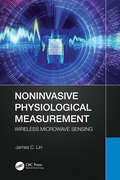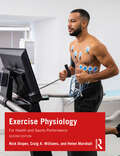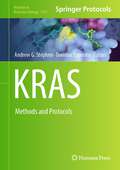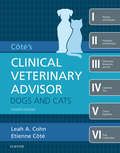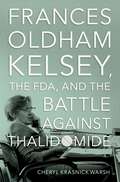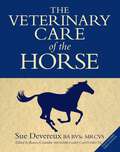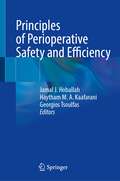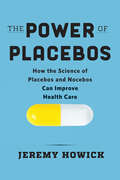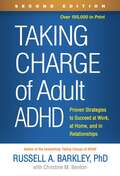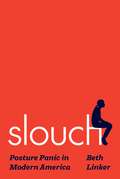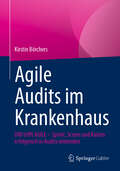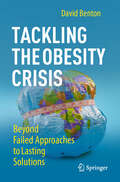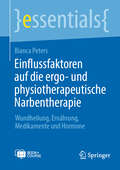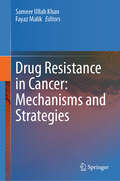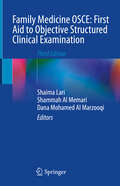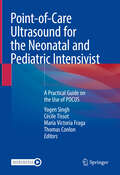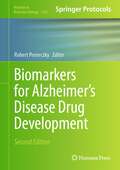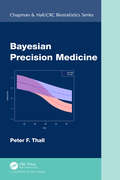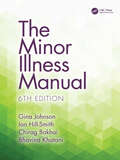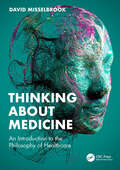- Table View
- List View
Noninvasive Physiological Measurement: Wireless Microwave Sensing
by James C. LinThis book explains the principles and techniques of microwave physiological sensing and introduces fundamental results of the noninvasive sensing of physiological signatures, vital signs, as well as life detection. Specifically, noninvasive microwave techniques for contact, contactless, and remote sensing of circulatory and respiratory movements and physiological volume changes are discussed.Noninvasive Physiological Measurement: Wireless Microwave Sensing, is written by a pioneering researcher in microwave noninvasive physiological sensing and leading global expert in microwaves in biology and medicine. The book reviews current advances in noninvasive cardiopulmonary sensing technology and measurement. It includes measurements of the vital signs and physiological signatures from laboratory and clinical testing. The book discusses the applicable domains and scenarios in which there is an interaction of radio frequency (RF) and microwaves with biological matter in gas, fluid, or solid form, both from inside and outside of the human or animal body. The book also provides examples for healthcare monitoring and diagnostic applications through wearables, devices, or remote contactless sensors for physiological signals and signature, vital signs, and body motion sensing. This book is an essential guide to understanding the human body’s interaction with microwaves and noninvasive physiological sensing and monitoring.This book is intended for researchers and professionals in biomedical, electrical, and computer engineering with an interest in antenna, sensors, microwaves, signal processing, and medical applications. It will also be of interest to healthcare professionals, technologists, and practitioners interested in noninvasive physiological sensing and patient monitoring.
Exercise Physiology: for Health and Sports Performance
by Nick Draper Craig Williams Helen MarshallThis second edition of Exercise Physiology: For Health and Sports Performance brings together all the essential human anatomy and applied physiology that students of exercise science, physical education, and sports coaching will need to know.Written in a friendly, accessible style, and containing a wide range of features to help develop understanding, this book provides a complete one-stop shop for exercise physiology broken down into three fundamental parts: foundations of exercise physiology, applied exercise physiology, and the new Part 3, exercise prescription.With Parts 1 and 2 examining the theory, testing, and practical applications of exercise physiology, the new Part 3 reflects the changes in the field by increasing focus on physical activity and diverse populations and helps provides a more complete course text for any exercise physiology course at universities around the world.This newly revised book is key reading for undergraduate and postgraduate students in the fields of exercise physiology, sports performance, sports therapy, fitness and personal training, and other related sport science courses.
Exercise Physiology: for Health and Sports Performance
by Nick Draper Craig Williams Helen MarshallThis second edition of Exercise Physiology: For Health and Sports Performance brings together all the essential human anatomy and applied physiology that students of exercise science, physical education, and sports coaching will need to know.Written in a friendly, accessible style, and containing a wide range of features to help develop understanding, this book provides a complete one-stop shop for exercise physiology broken down into three fundamental parts: foundations of exercise physiology, applied exercise physiology, and the new Part 3, exercise prescription.With Parts 1 and 2 examining the theory, testing, and practical applications of exercise physiology, the new Part 3 reflects the changes in the field by increasing focus on physical activity and diverse populations and helps provides a more complete course text for any exercise physiology course at universities around the world.This newly revised book is key reading for undergraduate and postgraduate students in the fields of exercise physiology, sports performance, sports therapy, fitness and personal training, and other related sport science courses.
KRAS: Methods and Protocols (Methods in Molecular Biology #2797)
by Andrew G. Stephen Dominic EspositoThis volume details protocols ranging from high yield production metabolically labeled KRAS for NMR studies to approaches that quantify engagement of novel molecules that bind KRAS in live cells. Chapters focus on protein production and characterization, biochemical assays, cell-based assays, KRAS-membrane interactions, targeting KRAS, and cell models. Written in the highly successful Methods in Molecular Biology series format, chapters include introductions to their respective topics, lists of the necessary materials and reagents, step-by-step, readily reproducible laboratory protocols, and key tips on troubleshooting and avoiding known pitfalls. Authoritative and cutting-edge, KRAS: Methods and Protocols aims to provide methods that will be instrumental in the development of future clinically approved KRAS therapeutics.
Cote's Clinical veterinary Advisor: Dogs and Cats - E-Book
by Leah Cohn Etienne CoteNEW! Expert Consult website with fully searchable eBook allows quick identification of any topic and its related information in the six different sections of the book. NEW! Fully revised and updated content plus dozens of all-new chapters, including: Hyperadrenocorticism (food-related) Meningoencephalitis of unknown etiology Hypercalcemia (feline idiopathic) Hops toxicosis Movement disorders Heart murmur (incidental finding) Polyneuropathy Urethral occluder placement Fecal transplant Bronchoalveolar lavage (blind) NEW! Informed client consent handouts provide simple explanations of procedures and denote foreseeable risks in both English and Spanish). NEW! Additional color images throughout the eBook increase the effectiveness of clinical photographs to showcase ophthalmologic and dermatologic conditions. NEW! Includes procedures and techniques rated in practical "do-ability" from 1 diamond (any vet should be able to read and do), to 3 diamonds (understanding procedure will facilitate conversation with clients but best performed through referral).
Frances Oldham Kelsey, the FDA, and the Battle against Thalidomide
by Cheryl Krasnick WarshThe woman scientist who saved Americans from thalidomide In the early 1960s, Dr. Frances Oldham Kelsey of the U.S. Food and Drug Administration became one of the most celebrated women in America when she prevented a deadly sedative from entering the U.S. market. A Canadian-born pharmacologist and physician, Kelsey saved countless Americans from the devastating side effects of thalidomide, a drug routinely given to pregnant women to prevent morning sickness. As the FDA medical officer charged with reviewing Merrell Pharmaceutical's application for approval in 1960-61, Kelsey was unconvinced that there was sufficient evidence of the drug's efficacy and safety. Despite substantial pressure, she held her ground for nineteen months while the extent of the drug's worldwide damage became known-thousands of stillborn babies, as well as at least 10,000 children across 46 countries born with severe deformities such as missing limbs, arms and legs that resembled flippers, and improperly developed eyes, ears, and other organs. As a result of Kelsey's efforts, thalidomide was never sold in the United States. The incident led Congress to pass the 1962 Drug Amendment, which fundamentally changed drug regulation in America. Those regulations, still in force today, required pharmaceutical companies to conduct phased clinical trials, obtain informed consent from participants in drug testing, and warn the FDA of adverse effects, and it granted the FDA important controls over prescription-drug advertising. One of a small minority of women to earn an advanced degree in science in the 1930s, Kelsey faced challenges that resonate with women scientists to this day. Revered by the public as a ?good mother of science,? she went on to act as a formidable gatekeeper against other suspect drugs, such as diesthylstilbestrol (DES) and laetrile. As part of the team that tested anti-malarial drugs on prisoner volunteers during World War II, she later was instrumental in the formulation of ethical protocols for drug testing on prisoners and the vulnerable, including the elderly and children. Yet behind the public adulation, she faced professional jealousies and glass ceilings, political interference with FDA's actions, and ongoing hostility from pharmaceutical industry officials. She was sustained and supported by family and friends, co-workers and mentors, and a lifetime commitment to good science. Based upon FDA archival records, private family papers, and interviews with family and colleagues, this biography brings to light the efforts and legacy of a pioneering woman of science whose contributions are still influential today.
Frances Oldham Kelsey, the FDA, and the Battle against Thalidomide
by Cheryl Krasnick WarshThe woman scientist who saved Americans from thalidomide In the early 1960s, Dr. Frances Oldham Kelsey of the U.S. Food and Drug Administration became one of the most celebrated women in America when she prevented a deadly sedative from entering the U.S. market. A Canadian-born pharmacologist and physician, Kelsey saved countless Americans from the devastating side effects of thalidomide, a drug routinely given to pregnant women to prevent morning sickness. As the FDA medical officer charged with reviewing Merrell Pharmaceutical's application for approval in 1960-61, Kelsey was unconvinced that there was sufficient evidence of the drug's efficacy and safety. Despite substantial pressure, she held her ground for nineteen months while the extent of the drug's worldwide damage became known-thousands of stillborn babies, as well as at least 10,000 children across 46 countries born with severe deformities such as missing limbs, arms and legs that resembled flippers, and improperly developed eyes, ears, and other organs. As a result of Kelsey's efforts, thalidomide was never sold in the United States. The incident led Congress to pass the 1962 Drug Amendment, which fundamentally changed drug regulation in America. Those regulations, still in force today, required pharmaceutical companies to conduct phased clinical trials, obtain informed consent from participants in drug testing, and warn the FDA of adverse effects, and it granted the FDA important controls over prescription-drug advertising. One of a small minority of women to earn an advanced degree in science in the 1930s, Kelsey faced challenges that resonate with women scientists to this day. Revered by the public as a ?good mother of science,? she went on to act as a formidable gatekeeper against other suspect drugs, such as diesthylstilbestrol (DES) and laetrile. As part of the team that tested anti-malarial drugs on prisoner volunteers during World War II, she later was instrumental in the formulation of ethical protocols for drug testing on prisoners and the vulnerable, including the elderly and children. Yet behind the public adulation, she faced professional jealousies and glass ceilings, political interference with FDA's actions, and ongoing hostility from pharmaceutical industry officials. She was sustained and supported by family and friends, co-workers and mentors, and a lifetime commitment to good science. Based upon FDA archival records, private family papers, and interviews with family and colleagues, this biography brings to light the efforts and legacy of a pioneering woman of science whose contributions are still influential today.
The Veterinary Care of the Horse: 3rd Edition
by Sue DevereuxThis enlarged third edition of The Veterinary Care of the Horse brings the reader up-to-date with recent developments in equine medicine and surgery. For ease of reference, each condition is explained under headings which include the causes, clinical signs, diagnosis, treatment, prevention and prognosis. It is appreciated that it is not always easy to remember every detail of the vet's instructions when coping with a sick or injured horse. For this reason, recommendations regarding everyday procedures such as cleaning a wound, poulticing and bandaging are laid out in a step-by-step format. Chapters include; The Healthy Horse; Preventive Medicine; the Ill or Injured Horse; Examination of the Lame or Poor Performance Horse; Diagnostic Procedures and Imaging Techniques; Conditions of the Horse's Foot; Tendon and Ligament Injuries; Joint Injury and Disease; Synovial Effusions; Conditions affecting Bone; Muscle Disease and Neurological Conditions; The Horse's Spine and Pelvis; Therapies; Complementary Therapies; Respiratory Conditions; The Horse's Heart and the Circulatory System; The Digestive System; The Horse's Skin; The Reproductive System; Endocrine Disorders; Eye Injury and Disease; Behaviour Problems; Veterinary Care of the Donkey; Veterinary Procedures and finally, Further Advice and Practical Tips. Edited by Karen Coumbe MA VetMB Cert EP MRCVS.An essential book for everyone concerned with the care and management of horses.Each condition is explained under headings which include the causes, clinical signs, diagnosis, treatment, prevention and prognosis.Recommendations regarding everyday procedures such as cleaning a wound, poulticing and bandaging are laid out in a step-by-step format.Fully illustrated with over 1400 colour photographs and 200 diagrams.A fully revised and enlarged third edition.Sue Devereux is a qualified vet and an equine instructor for the International Academy of Veterinary Chiropractic. Edited by Karen Coumbe MA VetMB Cert EP MRCVS.
Principles of Perioperative Safety and Efficiency
by Jamal J. Hoballah Haytham M. A. Kaafarani Georgios TsoulfasThe Power of Placebos: How The Science Of Placebos And Nocebos Can Improve Health Care
by Jeremy HowickThe Power Of Placebos: How The Science Of Placebos And Nocebos Can Improve Health Care
by Jeremy HowickTaking Charge Of Adult Adhd: Proven Strategies To Succeed At Work, At Home, And In Relationships
by Russell A. Barkley Christine M. BentonSlouch: Posture Panic in Modern America
by Beth LinkerThe strange and surprising history of the so-called epidemic of bad posture in modern America—from eugenics and posture pageants to today&’s promoters of &“paleo posture&”In 1995, a scandal erupted when the New York Times revealed that the Smithsonian possessed a century&’s worth of nude &“posture&” photos of college students. In this riveting history, Beth Linker tells why these photos were only a small part of the incredible story of twentieth-century America&’s largely forgotten posture panic—a decades-long episode in which it was widely accepted as scientific fact that Americans were suffering from an epidemic of bad posture, with potentially catastrophic health consequences. Tracing the rise and fall of this socially manufactured epidemic, Slouch also tells how this period continues to feed today&’s widespread anxieties about posture.In the early twentieth century, the eugenics movement and fears of disability gave slouching a new scientific relevance. Bad posture came to be seen as an individual health threat, an affront to conventional race hierarchies, and a sign of American decline. What followed were massive efforts to measure, track, and prevent slouching and, later, back pain—campaigns that reached schools, workplaces, and beyond, from the creation of the American Posture League to posture pageants. The popularity of posture-enhancing products, such as girdles and lumbar supports, exploded, as did new fitness programs focused on postural muscles, such as Pilates and modern yoga. By 1970, student protests largely brought an end to school posture exams and photos, but many efforts to fight bad posture continued, despite a lack of scientific evidence.A compelling history that mixes seriousness and humor, Slouch is a unique and provocative account of the unexpected origins of our largely unquestioned ideas about bad posture.
Agile Audits im Krankenhaus: DIN trifft AGILE - Sprint, Scrum und Kaizen erfolgreich in Audits einbinden
by Kirstin BörchersAudits im Krankenhaus werden oft noch sehr dokumentenlastig und auf ISO-Konformitätsprüfung ausgerichtet durchgeführt. Dabei geht es in Zeiten von E-Health, Digitalisierung und künstlicher Intelligenz (KI) im Krankenhaus längst um mehr und es ist vor allem eine flexiblere Herangehensweise gefordert. Die aktuellen Transformationsprozesse benötigen schnellere und dynamischere Anpassungen in der Organisation und bei den Abläufen. Mit Hilfe von agilen Audit-Instrumenten wie Scrum, Kaizen und Kanban können diese Herausforderungen gemeistert werden.Dieses Buch stellt nach einer Einführung in die Grundlagen von Audits die wichtigsten agilen Werte, Praktiken und Methoden vor, erläutert ihren möglichen Einsatz im Rahmen des allgemeinen Auditprozesses wie auch in den sogenannten „Audits im Sprint“. Agilität im Qualitätsmanagement und in der Durchführung interner Audits steht nicht im Widerspruch zum Leitfaden ISO 19011 „Auditierung von Managementsystemen“, in dem es um dieWirksamkeit und Eignung des QM-Systems sowie dessen Chancen zur Weiterentwicklung geht – sie ist vielmehr eine konsequente Weiterentwicklung. Best-Practice-Beispiele veranschaulichen, wie eine konkrete Umsetzung im Krankenhausumfeld aussehen kann.
Tackling the Obesity Crisis: Beyond Failed Approaches to Lasting Solutions
by David BentonThe obesity epidemic reflects a failure to understand how meals are chosen. Government initiatives have failed, and most people are unable to control their weight. In this book, an internationally recognized expert on diet and behaviour, discusses the common misunderstandings that have created the epidemic, and suggests how obesity could be reduced.After dieting the body needs fewer calories and you are likely to put on weight. Many people do not understand how to control their weight and rely on ideas that are simply wrong. Natural foods are seen as healthier when they are not. Ultra-processed foods are seen as a problem when the method of production is unimportant. There is little evidence that removing sugar from the diet, banning advertising to children, adding calories to menus, or providing nutritional information on packaging reduces obesity. In fact, removing fat from the diethas increased obesity.One conclusion is that current approaches have no chance of preventing obesity. Without new ways of dealing with obesity, it will inevitably increase, reducing life expectancy after decades of disease.So, what needs to change? One root cause of obesity is poverty. The way infants are fed in the first years of life determines the likelihood of obesity in adulthood. Without the development of low-calorie foods, little can be done. Since health policy depends on individuals changing their behaviour, they need to understand how to control their weight. Ambitious in scope, the author deals with the topic in an eye-catching and easy to understand manner, illustrated with colourful analogies and unusual and amusing facts. A refreshing novel perspective is offered that will be of interest to everyone wishing to control their body weight.
Einflussfaktoren auf die ergo- und physiotherapeutische Narbentherapie: Wundheilung, Ernährung, Medikamente und Hormone (essentials)
by Bianca PetersDie Wund- und Narbenheilung wird stark von der persönlichen Ernährung, dem Mikronährstoffhaushalt und der Einnahme von Medikamenten beeinflusst. Zudem können hormonelle Erkrankungen wie eine Schilddrüsenunterfunktion bzw. Autoimmunprozesse der Schilddrüse Einfluss darauf nehmen. Die Autorin erläutert wichtige komplexe Zusammenhänge zwischen der Gewebeheilung und den entscheidenden Einflussfaktoren. Weiterhin erklärt sie, welche konkreten Mikronährstoffmängel oder hormonellen Dysbalancen eine entscheidende Rolle dabei spielen.
Drug Resistance in Cancer: Mechanisms and Strategies
by Sameer Ullah Khan Fayaz MalikThis book tries to emphasize the mechanisms associated with the resistance towards various anti-cancer therapies The focus has been given to the role of cancer stem cells, immune cells, and the multiway impact of tumor microenvironment in drug resistance. The book delves into the role of epigenetic alterations, autophagy, intracellular compartments, and the impact of gut microbiome on therapeutic resistance. Each chapter of the book has elaborated on these aspects that are exclusively or mutually driving the therapeutic non-responsiveness towards various current clinical candidates. In addition to that the book has also discussed novel strategies to overcome the therapeutic challenge by employing combinatorial therapies that can prove to be useful and effective. Overall the book reflects on the current treatment challenges, futuristic strategies and new research initiatives that explore novel treatment options.
Family Medicine OSCE: First Aid to Objective Structured Clinical Examination
by Shaima Lari Shammah Al Memari Dana Al MarzooqiIn this book, a clinician can experience the most typical medical subjects in a primary care setting, which is the highlight. The book brings knowledge and counseling skills into action as it takes you through various scenarios. In addition, it serves as a guide for passing the Objective Structured Clinical Examination, or "OSCE," by mirroring the Middle East and Arab World exam format in a structured fashion. With that, the book left behind distinctive traces that productively revealed its value and reputation.The book chapters provide a systematic approach to patient-centered medical problems, making it easier and handier for the students. The process covers in-depth history remarks, an organized set of physical examinations, and careful counseling tips.
Point-of-Care Ultrasound for the Neonatal and Pediatric Intensivist: A Practical Guide on the Use of POCUS
by Yogen Singh Cécile Tissot María Victoria Fraga Thomas ConlonThis book, written by internationally renowned experts, is a comprehensive text covering all aspects and recommendations regarding the use of POCUS for critically ill neonates and children. Point of Care Ultrasound (POCUS) for the Neonatal and Pediatric Intensivist is structured to address and expand upon recently published international evidence-based POCUS guidelines endorsed by the European Society of Paediatric and Neonatal Intensive Care (ESPNIC). The book is richly illustrated and includes a robust collection of individual POCUS images and cases. The Electronic Supplementary Materials offer high quality and interesting video clips complementing reader learning, particularly for neonatology, pediatric critical care, and general pediatric providers. Chapter authors provide a practical, experience-based approach to clinical integration of POCUS applications and highlight relevant supportive literature as well as important limitations to POCUS use in the management of critically ill children. The information within the book is also intended to support further clinical and educational research in the practice of pediatric POCUS.
Biomarkers for Alzheimer’s Disease Drug Development (Methods in Molecular Biology #2785)
by Robert PerneczkyThis fully updated volume provides an up-to-date and comprehensive overview of the current state of technologies helping to accelerate Alzheimer’s disease drug development. Addressing the latest advances in preclinical and clinical research, including new insights into the molecular mechanisms and emerging therapeutic strategies, the book continues by exploring digital biomarkers and advanced neuroimaging analysis which will transform how clinical trials in the Alzheimer’s disease field are performed. Written for the highly successful Methods in Molecular Biology series, chapters feature the kind of detailed implementation advice that leads to greater success in the lab or clinic. Authoritative and practical, Biomarkers for Alzheimer’s Disease Drug Development, Second Edition seeks to inspire and inform future efforts to develop effective treatments for this devastating disease.
Bayesian Precision Medicine (Chapman & Hall/CRC Biostatistics Series)
by Peter F. ThallBayesian Precision Medicine presents modern Bayesian statistical models and methods for identifying treatments tailored to individual patients using their prognostic variables and predictive biomarkers. The process of evaluating and comparing treatments is explained and illustrated by practical examples, followed by a discussion of causal analysis and its relationship to statistical inference. A wide array of modern Bayesian clinical trial designs are presented, including applications to many oncology trials. The later chapters describe Bayesian nonparametric regression analyses of datasets arising from multistage chemotherapy for acute leukemia, allogeneic stem cell transplantation, and targeted agents for treating advanced breast cancer.Features: Describes the connection between causal analysis and statistical inference Reviews modern personalized Bayesian clinical trial designs for dose-finding, treatment screening, basket trials, enrichment, incorporating historical data, and confirmatory treatment comparison, illustrated by real-world applications Presents adaptive methods for clustering similar patient subgroups to improve efficiency Describes Bayesian nonparametric regression analyses of real-world datasets from oncology Provides pointers to software for implementation Bayesian Precision Medicine is primarily aimed at biostatisticians and medical researchers who desire to apply modern Bayesian methods to their own clinical trials and data analyses. It also might be used to teach a special topics course on precision medicine using a Bayesian approach to postgraduate biostatistics students. The main goal of the book is to show how Bayesian thinking can provide a practical scientific basis for tailoring treatments to individual patients.
Bayesian Precision Medicine (Chapman & Hall/CRC Biostatistics Series)
by Peter F. ThallBayesian Precision Medicine presents modern Bayesian statistical models and methods for identifying treatments tailored to individual patients using their prognostic variables and predictive biomarkers. The process of evaluating and comparing treatments is explained and illustrated by practical examples, followed by a discussion of causal analysis and its relationship to statistical inference. A wide array of modern Bayesian clinical trial designs are presented, including applications to many oncology trials. The later chapters describe Bayesian nonparametric regression analyses of datasets arising from multistage chemotherapy for acute leukemia, allogeneic stem cell transplantation, and targeted agents for treating advanced breast cancer.Features: Describes the connection between causal analysis and statistical inference Reviews modern personalized Bayesian clinical trial designs for dose-finding, treatment screening, basket trials, enrichment, incorporating historical data, and confirmatory treatment comparison, illustrated by real-world applications Presents adaptive methods for clustering similar patient subgroups to improve efficiency Describes Bayesian nonparametric regression analyses of real-world datasets from oncology Provides pointers to software for implementation Bayesian Precision Medicine is primarily aimed at biostatisticians and medical researchers who desire to apply modern Bayesian methods to their own clinical trials and data analyses. It also might be used to teach a special topics course on precision medicine using a Bayesian approach to postgraduate biostatistics students. The main goal of the book is to show how Bayesian thinking can provide a practical scientific basis for tailoring treatments to individual patients.
The Minor Illness Manual
by Gina Johnson Ian Hill-Smith Chirag Bakhai Bhavina KhataniThis sixth edition of the best-selling The Minor Illness Manual has been completely revised and updated to include the latest clinical guidance and prescribing information, with a reworked introductory chapter reflecting the changing demands of primary care and a new chapter added on COVID-19 and pandemics.The simple, clear and easy-to-use format gives primary care professionals – including doctors, nurses, pharmacists, physician associates and paramedics – speedy access to evidence-based guidance for dealing quickly and appropriately with the wide-ranging situations they are likely to encounter in their daily practice.
The Minor Illness Manual
by Gina Johnson Ian Hill-Smith Chirag Bakhai Bhavina KhataniThis sixth edition of the best-selling The Minor Illness Manual has been completely revised and updated to include the latest clinical guidance and prescribing information, with a reworked introductory chapter reflecting the changing demands of primary care and a new chapter added on COVID-19 and pandemics.The simple, clear and easy-to-use format gives primary care professionals – including doctors, nurses, pharmacists, physician associates and paramedics – speedy access to evidence-based guidance for dealing quickly and appropriately with the wide-ranging situations they are likely to encounter in their daily practice.
Thinking About Medicine: An Introduction to the Philosophy of Healthcare
by David MisselbrookThis introduction to the philosophy of medicine surveys the landscape of western philosophy as it pertains to healthcare in an accessible way. Written by a doctor for doctors and other health professionals, framing the 'toolbox' of philosophy within the community of medicine, it encourages examination of the implicit assumptions made in the construction of medical knowledge and practice.Taking the reader step by step through the concepts that underpin modern philosophy, they will be challenged to reflect upon the premises within clinical practice which might benefit from scrutiny and challenge, including the nature of scientific knowledge, the limits of our biomedical model, the cultural and relational context, and the failure to recognise or manage adequately the fact/value distinction in medicine and healthcare.The book is an ideal textbook for students of medicine and medical philosophy and will also be of interest to bioethicists, medical sociologists, clinical commissioners and to practicing clinicians in medicine and the allied health professions seeking to improve their understanding of philosophy and ethics and sharpen their critical thinking skills.
